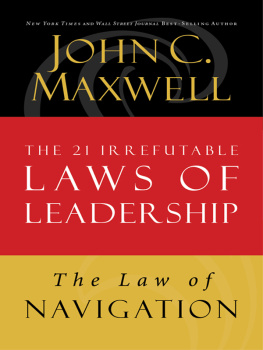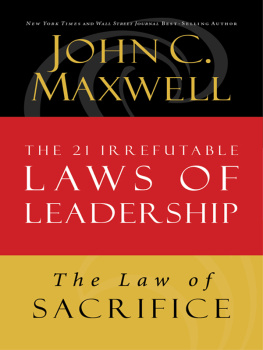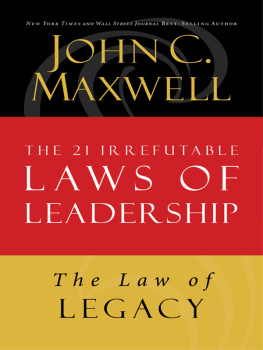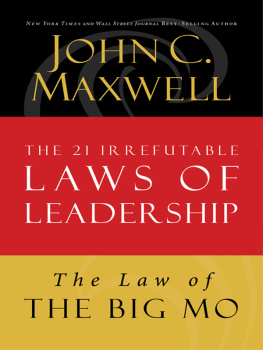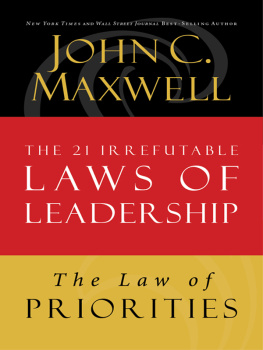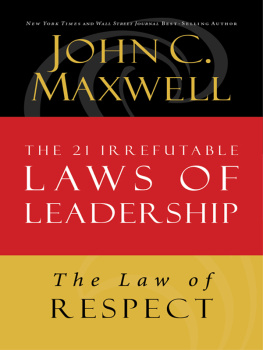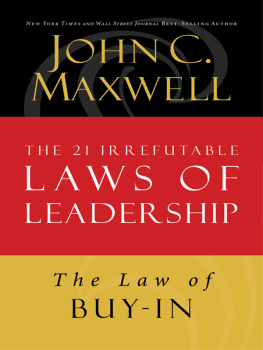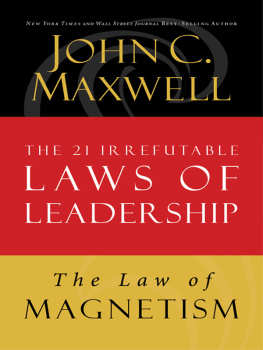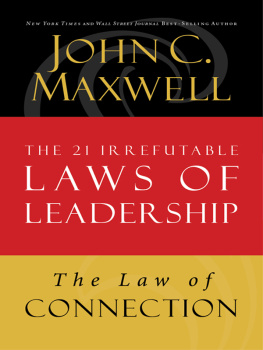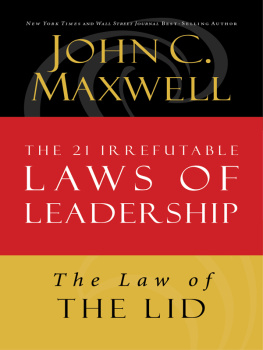
1998 and 2007 by John C. Maxwell
This ebook is derived from The 21 Irrefutable Laws of Leadership, by John Maxwell, 1998 and 2007 by Maxwell Motivation, Inc., a Georgia corporation.
All rights reserved. No portion of this book may be reproduced, stored in a retrieval system, or transmitted in any form or by any meanselectronic, mechanical, photocopy, recording, scanning, or otherexcept for brief quotations in critical reviews or articles, without the prior written permission of the publisher.
Published in Nashville, Tennessee, by Thomas Nelson. Thomas Nelson is a trademark of Thomas Nelson, Inc.
Thomas Nelson, Inc. titles may be purchased in bulk for educational, business, fund-raising, or sales promotional use. For information, please e-mail SpecialMarkets@ThomasNelson.com.
Published in association with Yates & Yates, LLP, Attorneys and Counselors, Orange, California.
Scripture quotations noted CEV are from THE CONTEMPORARY ENGLISH VERSION.
1991 by the American Bible Society. Used by permission.
Scripture quotations noted The Message are from The Message: The New Testament in Contemporary English. 1993 by Eugene H. Peterson.
ISBN 978-0-7852-7431-5 (HC)
ISBN 978-1-4185-3831-6 (ebook)
ISBN 978-1-4002-7563-2 (ebook of Chapter 4)

This book is dedicated to Charlie Wetzel, my writing partner since 1994. Together weve written more than forty books, and Ive enjoyed our collaboration on every one. As I have labored to add value to others by identifying and teaching leadership principles, Charlie, you have added value to me and my efforts. Your insights and skills as a wordsmith have been enjoyed by millions of readers. As a result, you have made a greater impact on more people than has anyone else in my inner circle. For that I thank you.
CONTENTS


Thank you to the thousands of leaders around the world who learned and sometimes challenged the laws of leadership, thus sharpening my thinking.
Thank you to the team at Thomas Nelson who gave me the chance to revise and improve this book, and especially to Tami Heim for her strategic leadership and to Victor Oliver who was instrumental in the development of the original concept.
Thank you to Linda Eggers, my executive assistant, and her assistant, Sue Caldwell, for their incredible service and willingness to go the extra mile every day.
Thank you to Charlie Wetzel, my writer, and Stephanie, his wife, with-out whose work this book would not have been possible.

Anyone Can Steer the Ship, but It
Takes a Leader to Chart the Course
In 1911, two groups of explorers set off on an incredible mission. Though they used different strategies and routes, the leaders of the teams had the same goal: to be the first in history to reach the South Pole. Their stories are life-and-death illustrations of the Law of Navigation.
One group was led by Norwegian explorer Roald Amundsen. Ironically, Amundsen had not originally intended to go to Antarctica. His desire was to be the first man to reach the North Pole. But when he discovered that Robert Peary had beaten him there, Amundsen changed his goal and headed toward the other end of the earth. North or southhe knew his planning would pay off.
AMUNDSEN CAREFULLY CHARTED HIS COURSE
Before his team ever set off, Amundsen had painstakingly planned his trip. He studied the methods of the Eskimos and other experienced Arctic travelers and determined that their best course of action would be to transport all their equipment and supplies by dogsled. When he assembled his team, he chose expert skiers and dog handlers. His strategy was simple. The dogs would do most of the work as the group traveled fifteen to twenty miles in a six-hour period each day. That would afford both the dogs and the men plenty of time for daily rest prior to the following days travel.
Amundsens forethought and attention to detail were incredible. He located and stocked supply depots all along the intended route. That way they would not have to carry every bit of their supplies with them the whole trip. He also equipped his people with the best gear possible. Amundsen had carefully considered every possible aspect of the journey, thought it through, and planned accordingly. And it paid off. The worst problem they experienced on their trip was an infected tooth that one man had to have extracted.
SCOTT VIOLATED THE LAW OF NAVIGATION
The other team of people was led by Robert Falcon Scott, a British naval officer who had previously done some exploring in the Antarctic area. Scotts expedition was the antithesis of Amundsens. Instead of using dogsleds, Scott decided to use motorized sledges and ponies. Their problems began when the motors on the sledges stopped working only five days into the trip. The ponies didnt fare well either in those frigid temperatures. When they reached the foot of the Transantarctic Mountains, all of the poor animals had to be killed. As a result, the team members themselves ended up hauling the two-hundred-pound sledges. It was arduous work.
Scott hadnt given enough attention to the teams other equipment either. Their clothes were so poorly designed that all of the men developed frostbite. One team member required an hour every morning just to get his boots onto his swollen, gangrenous feet. Everyone became snowblind because of the inadequate goggles Scott had supplied. On top of everything else, the team was always low on food and water. That was also due to Scotts poor planning. The depots of supplies Scott established were inadequately stocked, too far apart, and often poorly marked, which made them very difficult to find. Because they were continually low on fuel to melt snow, everyone became dehydrated. Making things even worse was Scotts last-minute decision to take along a fifth man, even though they had prepared enough supplies for only four.
After covering a grueling eight hundred miles in ten weeks, Scotts exhausted group finally arrived at the South Pole on January 17, 1912. There they found the Norwegian flag flapping in the wind and a letter from Amundsen. The other well-led team had beaten them to their goal by more than a month!
IF YOU DONT LIVE BY THE LAW OF NAVIGATION...
Scotts expedition to the Pole is a classic example of a leader who could not navigate for his people. But the trek back was even worse. Scott and his men were starving and suffering from scurvy, yet Scott, unable to navigate to the very end, was oblivious to their plight. With time running out and the food supply desperately low, Scott insisted that they collect thirty pounds of geological specimens to take backmore weight to be carried by the worn-out men.
The groups progress became slower and slower. One member of the party sank into a stupor and died. Another, Lawrence Oates, a former army officer who had originally been brought along to take care of the ponies, had frostbite so severe that he had trouble doing anything. Because he believed he was endangering the teams survival, he purposely walked out into a blizzard to keep from hindering the group. Before he left the tent and headed into the storm, he said, I am just going outside; I may be some time.
Next page
